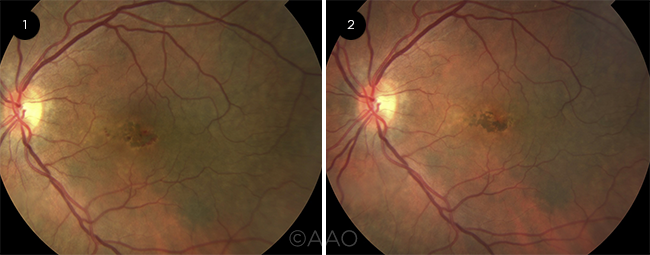Download PDF
Despite warnings, injuries with dual-mode laser capsulotomy/selective laser trabeculoplasty (SLT) laser systems continue to occur. A team of retina subspecialists recently presented a case of a 65-year-old woman whose left macula was scarred when capsulotomy was attempted using the system’s SLT mode.1
This is not the first publication to warn of the potential for serious injury when dual-mode capsulotomy/SLT systems are operated in the wrong mode.2 However, published reports of misuse have been scarce. Moreover, gag rules imposed in malpractice settlements prohibit publication of cases, including two other current cases known to the authors.1
 |
INJURY. (1) Baseline fundus photograph shows foveal retinal pigment epithelium (RPE) mottling from multiple laser lesions. (2) Three months later, traumatic RPE hyperplasia is more prominent, while surrounding hemorrhages have resolved.
|
Lack of awareness. “Many clinicians are unaware of and often surprised to learn of this serious recurrent injury,” said coauthor Martin A. Mainster, PhD, MD, at the University of Kansas School of Medicine in Kansas City. “The SLT mode of a capsulotomy-SLT laser system can cause devastating, permanent foveal damage when it’s used erroneously in an attempted capsulotomy.”
Current case report. Dr. Mainster and his colleagues described the case of a woman who underwent cataract surgery—and then, a year later, required capsulotomy for each eye. Although the treatment of her right eye was successful, the capsulotomy of her left eye failed, and she reported severe vision loss in that eye one week later.
She was referred to the authors, and imaging revealed permanent macular and extramacular photothermal and photomechanical damage. The best-corrected visual acuity (BCVA) in her left eye declined from 20/30 to 20/400. Within three months, the BCVA in that eye was count fingers at 4 feet, and she was informed of her poor visual prognosis. The diagnosis: laser maculopathy. “SLT mode laser pulses passing through a patient’s pupil reach and destroy retinal tissue,” Dr. Mainster said.
How these accidents occur. These incidents occur when the laser system is inadvertently turned on in its SLT mode or left on after an SLT procedure for others to use, Dr. Mainster said. He explained, “A clinician performing a capsulotomy might confuse the SLT mode’s single-spot capsular reflection with the in-focus fusion of the capsulotomy mode’s multiple-spot–aiming interface.”
How to prevent further incidents. To prevent similar iatrogenic injuries, the authors recommend taking the following steps:
- Have clinicians—not technicians—select the laser delivery mode.
- Double-check the laser mode before treating.
- Enhance engineering controls, such as different-colored backgrounds for each laser mode on a touch screen.
- Require entry of a personal identification number by clinicians—not technicians—to acknowledge a warning before the SLT mode can be used.
- Affix a conspicuous note to every machine warning users never to attempt capsulotomy when the device is in SLT mode.
Ounce of prevention. Administrative and engineering controls could have prevented the woman’s injury, but such controls were either absent or ignored, the authors wrote.
With regard to treatment, Dr. Mainster said that treatments such as anti-inflammatory and neuroprotective drugs are usually ineffective for severe macular injuries. As he noted, “The best way to treat a laser injury is to prevent it.”
—Miriam Karmel
___________________________
1 Ledesma-Gil G et al. Ophthalmology. Published online May 17, 2020.
2 Liyanage SE et al. Br J Ophthalmol. 2014;98(1):141-142.
___________________________
Relevant financial disclosures—Dr. Mainster: Ocular Instruments: C.
For full disclosures and the disclosure key, see below.
Full Financial Disclosures
Dr. Mainster Ocular Instruments: C.
Dr. Menko None.
Dr. Niffenegger None.
Dr. Tonorezos This study was supported by the National Cancer Institute’s Intramural Research Program, a Sloan-Kettering Institute of Cancer Research Cancer Center Support Grant (P30CA008748), and the Meg Berté Owen Fund. The funding sources had no role in the study design, data acquisition, analysis, manuscript preparation, or decision to submit this work.
Disclosure Category
|
Code
|
Description
|
| Consultant/Advisor |
C |
Consultant fee, paid advisory boards, or fees for attending a meeting. |
| Employee |
E |
Employed by a commercial company. |
| Speakers bureau |
L |
Lecture fees or honoraria, travel fees or reimbursements when speaking at the invitation of a commercial company. |
| Equity owner |
O |
Equity ownership/stock options in publicly or privately traded firms, excluding mutual funds. |
| Patents/Royalty |
P |
Patents and/or royalties for intellectual property. |
| Grant support |
S |
Grant support or other financial support to the investigator from all sources, including research support from government agencies (e.g., NIH), foundations, device manufacturers, and/or pharmaceutical companies. |
|
More from this month’s News in Review